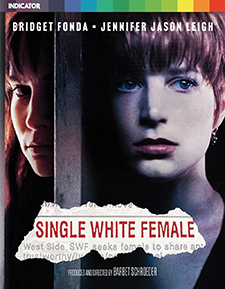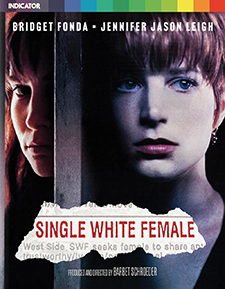Single White Female (Region B) (Blu-ray Review)

Director
Barbet SchroederRelease Date(s)
1992 (July 22, 2024)Studio(s)
Columbia Pictures (Indicator/Powerhouse Films)- Film/Program Grade: C-
- Video Grade: A-
- Audio Grade: A
- Extras Grade: A
Review
[Editor’s Note: This is a Region B-locked UK import.]
Two terrific leading performances can’t hide the fact that Single White Female (1992) is a perfectly dreadful psychological thriller, lacking credibility in its first third before going completely off the rails by the end. One can’t help but notice a lot of fine talent so wasted on a project far below their abilities.
Based on John Lutz’s 1990 novel SWF Seeks Same, the film version stars Bridget Fonda as Allie Jones, a Manhattan-based software designer who as the story begins learns that her fiancé, Sam Rawson (Steven Weber, now on Chicago Med) recently had sex with his ex-wife. Allie kicks him out of her sprawling rent-controlled Upper West Side apartment, which she obtained as part of a settlement with her ex-business partner. Lonely, she advertises for a roommate, eventually settling on mousy but friendly Hedra Carlson (Jennifer Jason Leigh).
At first, the arrangement seems ideal, but when Sam pushes for a reconciliation with Allie, Hedra’s serious psychological problems bubble to the surface: she erases Sam’s phone messages, hides his contrite letters to Allie and, resentful of an adopted puppy’s affection for the reconciling couple, tosses the pooch from a 14-story window, blaming Sam for the dog’s death. Later Hedra, an identical twin whose sister died years before, begins obsessively copying Allie’s hairstyle, buying identical sets of clothes, and even muscles in on her sexual relationship with Sam, whom by this point is staying over at the apartment.
One dispiriting aspect of Single White Female is watching the fully-committed performances of Fonda and especially Leigh, revealing much raw, authentic emotion as well as both frequently appearing nude and semi-nude in the service of the story (though at times for no clear reason), dedication unworthy of such mediocre material. Leigh’s character, portrayed with clinical authenticity, seems a jumble of many psychological disorders, as if the screenwriters knew enough to shrewdly incorporate real symptoms of real mental illnesses, but ultimately jumbling it all together so that the final result a bat shit-crazy femme psycho in the Fatal Attraction mold.
This is one of those frustrating thrillers in which the protagonist, Allie in this case, continues rooming with Hedra long after it’s obvious to the audience that this unhinged young woman is clearly highly dangerous. Why is Allie so stupid? Any normal woman would have moved out and gone straight to the police by the third reel. In one scene, it’s the middle of the night and Allie pretends to be asleep in her bed with Sam when Hedra quietly enters their room, hovering over them menacingly before slipping out again. Allie does nothing about this. When she finds a shoebox containing letters from Sam that Hedra intercepted and hid away, along with photos of Hedra and her twin sister (proving that she lied about her sibling dying at childbirth), again Allie stays put, not overly concerned. None of this is believable.
The fine character actor Stephen Tobolowsky appears as Mitchell Myerson, Allie’s first and apparently only client. He exists solely to murdered by Hedra later, and to provide an unsavory scene where he sexually assaults Allie. Incredibly, she “just wants to forget it,” one of several instances in the film that, in the guise of an “erotic thriller,” distastefully exploits its female leads.
Inevitably, there’s a violent, protracted climatic fight to the death at the end, complete with ice picks, handguns, and screwdrivers. How will the survivor explain all this to the police?
At the time of its release, the cinematography by Luciano Tovoli (The Passenger, Suspiria) was widely praised, but it’s no more sensible than the rest of the picture. Allie seems to have some kind of grudge against light bulbs; the cave-like interiors are dark and shadowy, with 90% of what light there is coming through windows rather than indoor lamps. Although the screenwriters deserve some credit trying to explain how Allie could afford such a huge, luxurious Manhattan apartment, it’s still not credible. Over the course of the film she has zero income while Hedra seems only to have a part-time job at a bookstore. How do they live? Director Barbet Schroeder used The Ansonia, the “Palace for the Muses,” whose tenants through the years included Enrico Caruso, Gustav Mahler, Babe Ruth, Igor Stravinsky and Arturo Toscanini. At the time of filming an apartment the size depicted in the film would easily have cost half a million dollars. Not bad for a 20-something with no measurable income.
Certain aspects of the film are amusing 33 years on. Allie is a fashion plate envied by plain-Jane Hedra yet, in retrospect, Allie’s clothes and hairstyles have dated badly while Hedra’s thrift store wardrobe would wear well today. Likewise, Allie’s cutting-edge business as a software designer using primitive PCs would hardly pass muster in 2004, let alone 2024.
Indicator’s Blu-ray release of Single White Female is described as a “high-definition remaster,” the 1.85:1 widescreen image a bit on the grainy side, not unusual with many Hollywood-made ‘90s titles, but pleasing enough. The stereo surround is up to early-‘90s standards, with fairly good use of directional sound effects, and Howard Shore’s musical score comes off well. Optional English subtitles are provided on this Region “B” encoded disc.
Supplements include a 2018 commentary with director Schroeder, editor Lee Percy, and associate producer Susan Hoffman; 2018 on-camera interviews with Schroeder, actor Peter Friedman (who plays Allie’s upstairs neighbor), Steven Weber, and screenwriter Don Ross; and a new video essay called She’ll Follow You Anywhere features writer Anna Bogutskaya. Also included is a trailer and image gallery.
For this review, we received check discs only. The booklet packaged with the final release includes a new essay by Georgia Humphreys, archival essays, and articles about the making of the film.
Contemporary reviews likened Single White Female to classic thrillers such as Vertigo and Rosemary’s Baby, but the truth is the picture is completely lacking those films’ carefully constructed plots and intricate visual storytelling. Single White Female is simply not believable on any level. It’s just an overwrought, despairing potboiler.
- Stuart Galbraith IV

